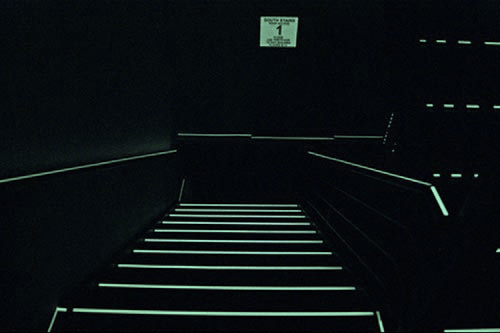Two weeks ago, the Everything Immersive community was up in arms over a very serious safety infraction that resulted in injury to audience members and could have resulted in death. We were all understandably shaken by it.
- No Proscenium reports about the incident here.
- A harrowing first-hand account of what happened is here.
- No Proscenium also talks about safety with leaders in the immersive haunt genre in their recent podcast (starting about 22:20) here.
Too long, didn’t listen: if you’re not an expert in the field of carpentry or aerial hi-jinks or waterboarding or what-have-you, consult with someone who is an expert to make sure your intended use in the show is as safe as possible. Also, TAKE THE TIME TO BUILD YOUR IMMERSIVE RIGHT. These things do not go up in a couple of months. Only sloppy and unsafe shows go up that quickly.
Since Immersology serves as a platform for the practice of immersive theatre—the big picture, if you will—I feel a need to weigh-in officially on the issue of safety, something we cannot take for granted in this genre.
Immersive designers: your audience is active. They may behave unpredictably. Your behavior to them is also unpredictable. You’re probably planning to do unusual and surprising things to them—that’s why this is fun. For fuck’s sake, make it safe. Really, really safe. That includes, but is not limited to…
- No lifting, overturning, or throwing of furniture or other heavy objects
- Creating clear safe spaces for the audience during vigorous action sequences
- No audience-navigation in complete darkness
- Poorly-lit stairs or other uneven surfaces feature glow-tape

- First aid kits and fire extinguishers on-site (and every company member knows where they are)
- No one locked in or locked up (handcuffs) without a user-operated safety release
- All lighting instruments safety-cabled
- Emergency lighting in case of power outage
- Limited use of glass, and if there’s glass in the space, that space is monitored
- No unfinished wood

- Clear rules of engagement for the audience
- Proper advance warning for potentially awful stuff inside the show—whether that’s a strawberry cocktail (I’m allergic), forced enclosure in tight spaces, crawling, spanking, simulated drowning, etc.
These are the basics—and they apply to escape rooms, too, who in my experience are the more egregious violators of the above.
But there’s still a lot left off that list that we can do. Design “X” with an eye on that 0.01% chance that “X” fails catastrophically. If you plan to run a lot, you just might see that 0.01% come due. See what you can do to prevent that from ever happening.
But even with the smartest designers in the world, stuff can still go wrong. That’s where your well-trained actors can step in.
Calling Hold
Your actors are the enforcers of the rules and the guardians of the show. But they’re also committed to not breaking character, and they may want to carry on when something goes wrong. Break them of that instinct. Train them to call HOLD whenever they want to.
As creators, we think of HOLD as the worst thing possible, the nuclear option, the apocalyptic experience that breaks the magic. But I’ve been on the audience side of a very long hold once, and we didn’t care. We loved the show enough to wait in silence. I’ve also been on the actor side of a few holds, as escape rooms are rather notorious for something small but essential bringing the entire game to a halt. Really: your audience does not care. They’ll jump back in the moment you release them. In fact, they’ll recognize that you’re giving them the best service possible by addressing the problem, instead of letting the problem fester.
Get the whole cast comfortable with HOLD. Have a procedure for HOLD. Especially if a safety concern occurs, call HOLD.
Establishing safe space
Violent or dance-based immersives need to consider how they will train their audience to get out of the way—and stay out of the way. Third Rail Projects sits you in chairs, or they crawl up on set pieces you’re clearly not meant to access. The space of the McKittrick also has quality safe spaces: think of the step along the wall in the speakeasy during Banquo’s murder or the platform for spectators during the door dance. When it matters most, the actors and black masks make it quite clear that you are not to leave this space. Only an idiot would leave these spaces—although I’m sure someone has.
Black Masks
The cast of Sleep No More do an excellent job of crowd control and establishing spaces for their work, but it’s the Black Masks who really get the safety job done. They’re always there when it gets dicey: Lady Macduff’s murder, the prophecy rave, the banquet table you can’t join, the box you can’t crawl into.
If you’re building a sandbox show, consider if you need a few black masks to ensure safety both for audience and for actors. (They’re also essential to show-function: I definitely saw a black mask deliver Macbeth his missing pants once. Someone really wanted his pants that night).
Disney Keys
Ricky Brigante of Inside the Magic taught me on FB about the Disney Parks tiered-value system, known as the four keys. I think it expresses succinctly how actors should behave in immersives, and Strange Bird Immersive has since adopted the policy.

Here’s what I put in our actor code of conduct…
#1 – Safety. Safety must be the priority in every decision we make and must never be sacrificed for another key. Address directly any audience member’s safety concern, and if a safety issues arises, call HOLD until the issue is resolved.
#2 – Courtesy. Never forget that the audience is a paying customer, and you are performing a guest-service role. Stay respectful. When in conflict, courtesy should trump your character’s response (i.e. Do NOT get in a yelling match with an audience member, even if that’s “what your character would do”).
#3 – Show. Serve the story and play your character as much as you can—this is what they paid to be a part of. Do your absolute best not to break the world.
#4 – Efficiency. Try to keep on schedule. Use your time and resources wisely to maximize every guest’s experience.
Audience responsibility
But audience safety is not only up to the designers and actors. It is ultimately up to YOU, the audience member.

I know you want to tail that actor, I know you want a hero moment, I know you’ll do anything to maximize your experience, but please, BE AWARE OF YOUR BODY.
That includes, but is not limited to…
- Not launching your body in the path of an actor
- Not launching your body in the path of an audience member
- Not getting in the actor’s face (we’re human, after all, and don’t know you)
- Generally being respectful of the actors. If you’re unsure how they want you to interact with them, default to passive-mode until they signal otherwise
- Watching from a safe position or space
- No lifting, overturning, or throwing of furniture or any other objects (FYI no escape room tapes a key to the back of a very heavy desk)
- Taking care on stairs
- Accepting your physical limits and not pushing yourself to a breaking point
- Being ready to say NO anytime you don’t want to do something
You are the person who is in ultimate control of your safety. Please don’t “give yourself up” to these experiences so much that you never ask, “Am I safe doing this?”
Especially in the wild west of this new genre, you may enter an immersive space where the designers have NOT done any of the above. Be aware. Take care. And remember that you can always NOPE the fuck out of there.
Waiver 101
DISCLAIMER: the following is non-professional legal advice. This is the result of my personal research. Nothing can replace consulting a real contract lawyer. And FFS, stop copying the waivers of your peers.
Waivers: you’re probably doing it wrong. If you really want it to hold up in court, you need to give the plaintiff absolutely ZERO excuses for why they retained the right to sue you despite having signed your waiver.
Here’s how to do a proper waiver…
- Keep it as short as possible, so people will read it. If I have to scroll on the iPad, it’s too long. Bullet point the assumed risks in the experience and state that I waive your liability. That’s all you need.
- Keep it as clear as possible, so people understand it. That means no legalese.
- Provide one waiver per person. If there’s any sort of “line” at the waiver stations, then there’s social pressure to sign it without reading it. (That pretty much means if you’re doing iPad waivers, you need an iPad for every single person who arrives at a given time. Not very feasible). No “one waiver per team” on a clipboard that gets passed around, either.
- In the state of Texas, no waiver for anyone under the age of 18, whether signed by a guardian or not, will hold up in court. Just FYI. That’s a good reason to have that age limit.
But ultimately, waivers are not about that day in court. They are about preventing that day in court. I think they are an important step in the immersive process: they create a transitional moment for the audience to pause, realize that they’re about to start behaving very differently, and acknowledge that they will face certain risks. It’s that reminder that YOU are ultimately responsible for YOUR safety.
I’m sure we could all use that reminder before Sleep No More. WHERE THE HELL IS THEIR WAIVER???
What about actor safety?
I’ve only talked about audience safety so far, but actor safety is an even harder issue.
Read this WSJ report, if you haven’t already:
“Audience Behavior Makes Immersive Theatre Highly Unpredictable” (Dec 2016) (follow this FB link to get around their paywall)
It’s important to keep some perspective here. After some 140+ shows, I have not one story fit for this article of an audience member who crossed the line. But we are talking about that 0.01% chance, and it never hurts to be prepared.
Good news is the experience does filter out the craziest of the public via paid tickets. People don’t usually drop $40-200 just to molest actors. But sometimes it was the friend’s idea to go, and you end up with an audience member who wants to break the world and so poses a risk to your actors.
Plan for that risk. That includes, but is not limited to…
- Designing experiences that don’t prompt seriously inappropriate behaviors (care in particular should be taken with 1-on-1s)
- Hiring actors who know how to handle themselves and have the instinct to stand their ground or fly, rather than fight back
- Training actors in HOLD and other audience-control tactics
- Having doors for 1-on-1s that can lock out audiences outside but never lock in those inside
- Establishing escape routes when an interaction goes south
- Establishing a safe-word to use if an actor needs assistance of a company member
Again, Black Masks can provide crucial assistance, as they can protect actors and audience alike. (The trouble is, of course, paying for your glorified security team.)
None of these are perfect remedies, however. We won’t have a perfectly safe immersive until all the world agrees that we be respectful of each other when we interact, whether inside an imaginary world or not.
THe Stakes
Please, please don’t forget about safety. All we need is one negligent audience member inside one negligent show to bring the entire genre crashing down.

